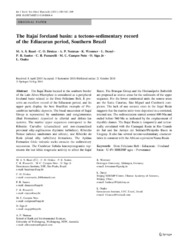The Itajaí foreland basin: a tectono-sedimentary record of the Ediacaran period, Southern Brazil
Basei, M.
Drukas, C.
Nutman, A.
Wemmer, K.
Dunyi, L.
Santos, P.
Passarelli, C.
Campos Neto, M.
Siga, O.
Osako, L.
100, 2/3: 543 - 569
DOI: https://doi.org/10.1007/s00531-010-0604-4
Persistent URL: http://resolver.sub.uni-goettingen.de/purl?gldocs-11858/6784
Persistent URL: http://resolver.sub.uni-goettingen.de/purl?gldocs-11858/6784
Basei, M.; Drukas, C.; Nutman, A.; Wemmer, K.; Dunyi, L.; Santos, P.; Passarelli, C.; Campos Neto, M.; Siga, O.; Osako, L., 2010: The Itajaí foreland basin: a tectono-sedimentary record of the Ediacaran period, Southern Brazil. In: International Journal of Earth Sciences, Band 100, 2/3: 543 - 569, DOI: 10.1007/s00531-010-0604-4.
 |
View/
|
The Itajaí Basin located in the southern border of the Luís Alves Microplate is considered as a peripheral foreland basin related to the Dom Feliciano Belt. It presents an excellent record of the Ediacaran period, and its upper parts display the best Brazilian example of Precambrian turbiditic deposits. The basal succession of Itajaí Group is represented by sandstones and conglomerates (Baú Formation) deposited in alluvial and deltaic-fan systems. The marine upper sequences correspond to the Ribeirão Carvalho (channelized and non-channelized proximal silty-argillaceous rhythmic turbidites), Ribeirão Neisse (arkosic sandstones and siltites), and Ribeirão do Bode (distal silty turbidites) formations. The Apiúna Formation felsic volcanic rocks crosscut the sedimentary succession. The Cambrian Subida leucosyenogranite represents the last felsic magmatic activity to affect the Itajaí Basin. The Brusque Group and the Florianópolis Batholith are proposed as source areas for the sediments of the upper sequence. For the lower continental units the source areas are the Santa Catarina, São Miguel and Camboriú complexes. The lack of any oceanic crust in the Itajaí Basin suggests that the marine units were deposited in a restricted, internal sea. The sedimentation started around 600 Ma and ended before 560 Ma as indicated by the emplacement of rhyolitic domes. The Itajaí Basin is temporally and tectonically correlated with the Camaquã Basin in Rio Grande do Sul and the Arroyo del Soldado/Piriápolis Basin in Uruguay. It also has several tectono-sedimentary characteristics in common with the African-equivalent Nama Basin.
Statistik:
View StatisticsCollection
- Geologie [930]

